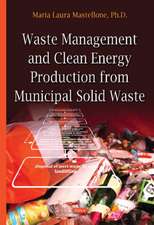Environmental Systems Analysis with MATLAB®
Autor Stefano Marsili-Libellien Limba Engleză Hardback – 3 mar 2016
The book follows a logical sequence from the basic steps of model building and data analysis to implementing these concepts into working computer codes, and then on to assessing their results. It describes data processing (rarely considered in environmental analysis); outlines the tools needed to successfully analyze data and develop models, and moves on to real-world problems. The author illustrates in the first four chapters the methodological aspects of environmental systems analysis, and in subsequent chapters applies them to specific environmental concerns.
The accompanying software bundle is freely downloadable from the book web site. It follows the chapters sequence and provides a hands-on experience, allowing the reader to reproduce the figures in the text and experiment by varying the problem setting. A basic MATLAB literacy is required to get the most out of the software.
Ideal for coursework and self-study, this offering:
- Deals with the basic concepts of environmental modeling and identification, both from the mechanistic and the data-driven viewpoint
- Provides a unifying methodological approach to deal with specific aspects of environmental modeling: population dynamics, flow systems, and environmental microbiology
- Assesses the similarities and the differences of microbial processes in natural and man-made environments
- Analyzes several aquatic ecosystems’ case studies
- Presents an application of an extended Streeter & Phelps (S&P) model
- Describes an ecological method to estimate the bioavailable nutrients in natural waters
- Considers a lagoon ecosystem from several viewpoints, including modeling and management, and more
| Toate formatele și edițiile | Preț | Express |
|---|---|---|
| Paperback (1) | 467.55 lei 6-8 săpt. | |
| CRC Press – 12 feb 2018 | 467.55 lei 6-8 săpt. | |
| Hardback (1) | 1360.95 lei 6-8 săpt. | |
| CRC Press – 3 mar 2016 | 1360.95 lei 6-8 săpt. |
Preț: 1360.95 lei
Preț vechi: 1659.69 lei
-18% Nou
Puncte Express: 2041
Preț estimativ în valută:
260.45€ • 270.91$ • 215.02£
260.45€ • 270.91$ • 215.02£
Carte tipărită la comandă
Livrare economică 15-29 aprilie
Preluare comenzi: 021 569.72.76
Specificații
ISBN-13: 9781498706353
ISBN-10: 1498706355
Pagini: 562
Ilustrații: 503 colour illustrations, 40 black & white tables
Dimensiuni: 178 x 254 x 33 mm
Greutate: 1.43 kg
Ediția:1
Editura: CRC Press
Colecția CRC Press
ISBN-10: 1498706355
Pagini: 562
Ilustrații: 503 colour illustrations, 40 black & white tables
Dimensiuni: 178 x 254 x 33 mm
Greutate: 1.43 kg
Ediția:1
Editura: CRC Press
Colecția CRC Press
Public țintă
Academic and Professional Practice & DevelopmentCuprins
Introduction. Identification of Environmental Models. Analysis of Environmental Time Series. Fuzzy Modelling of Environmental Systems. Population Dynamics Modelling. Flow Reactor Modelling. Microbial Kinetics Modelling. Analysis of Aquatic Ecosystems. References.
Notă biografică
Stefano Marsili-Libelli received a cum laude MS degree in electronic engineering from the University of Pisa in 1973. Later that same year, he joined the University of Florence and since that time has served on the engineering faculty—first as a technical assistant, then as an associate professor (1983), and finally as a full professor (2000). A founding member of the environmental engineering curriculum at the University of Florence, he is also director of the Laboratory of Environmental Process Control, and an associate editor for the ISI international journals Environmental Modelling & Software and Water Science & Technology.
Recenzii
"… a clear and comprehensive exposition of not only the fundamental mathematical and statistical techniques needed to model environmental systems, but also of the underlying philosophy that produces models that are physically realistic and result in predictions that are relevant to taking action in the real world. The development of material in each chapter is lucid and will be accessible to students and the novice modeler, yet detailed enough to be of interest to experienced researchers. The example situations that are modeled are both interesting and timely. … This work is destined to become a classic in the environmental modeling literature."
—William D. Lakin, Ph.D., Professor of Mathematics, Statistics, and Biomedical Engineering, Emeritus, The University of Vermont, Burlington, USA
"This book is a must for those starting out on modeling and for those who need more technical background, and indeed pragmatic guidance, the latter partly deriving from the author’s wealth of experience. Beautifully written and illustrated in a truly didactic way, it uses ecological models much of the time to give focus. But it really is an excellent book for anyone interested in understanding systems and their key concepts and methods. A bonus for students and teachers is the provision of MATLAB® based exercises to reinforce the learning potential and enhance skill development."
—Tony Jakeman, Australian National University, Canberra
—William D. Lakin, Ph.D., Professor of Mathematics, Statistics, and Biomedical Engineering, Emeritus, The University of Vermont, Burlington, USA
"This book is a must for those starting out on modeling and for those who need more technical background, and indeed pragmatic guidance, the latter partly deriving from the author’s wealth of experience. Beautifully written and illustrated in a truly didactic way, it uses ecological models much of the time to give focus. But it really is an excellent book for anyone interested in understanding systems and their key concepts and methods. A bonus for students and teachers is the provision of MATLAB® based exercises to reinforce the learning potential and enhance skill development."
—Tony Jakeman, Australian National University, Canberra
Descriere
The book explains how to use leading-edge numerical techniques to develop simple but successful models of environmental processes or to analyze environmental data sets. Ready-made computer codes in Matlab are available to assist the reader in adapting his or her problem to the theory described here. The material is organized in such a way that the book can be used either as an end-to-end textbook in Environmental Systems Analysis or as a handbook to address a specific problem.





















